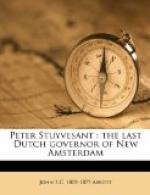All hands now went to work energetically. While thus employed a band of Indian warriors, in their most showy attire, was seen approaching. It was feared that they were on the war path, and the soldiers immediately stood to their arms. It is undeniable that the Indians seemed ever disposed to cherish kindly feelings when justly treated.
These kind hearted savages fifty in number, notwithstanding all the wrongs which they had endured, came forward and one of them, addressing the governor, said,
“In token of our good will, and that we have laid aside all malice, we request the Grand Sachem to accept as a free present, the land on which he has commenced his settlement. We give it to grease his feet, as he has undertaken so long and painful a journey to visit us.”
The labor of three weeks completed the defences. The buildings were reared within the enclosure. A strong guard-house, sixteen feet by twenty-three, was built in the northeast corner of the village. A bridge was thrown across the creek, and temporary quarters were erected for the soldiers. The energetic governor having accomplished all this in a month, left twenty-four soldiers behind him to guard the village, and returned to Manhattan.
In 1658, the little settlement of New Amstel presented quite a flourishing appearance. It had become a goodly town of about one hundred houses, containing about five hundred inhabitants. As many of these were Waldenses, Swedes and emigrants from other nationalities, they seemed to think themselves independent of the provincial authorities at New Amsterdam. The governor therefore visited the place in person, and called upon all to take the oath of allegiance.
There was great jealousy felt by the governor in reference to the encroachments of the English. They were pressing their claims everywhere. They were establishing small settlements upon territory undeniably belonging to the Dutch. English emigrants were crowding the Dutch colonies and were daily gaining in influence. Though they readily took the oath of allegiance to the Dutch authorities, all their sympathies were with England and the English colonies.
The Directors of the Company wrote to Stuyvesant recommending him
“to disentangle himself in the best manner possible from the Englishmen whom he had allowed to settle at New Amstel. And at all events not to admit any English besides them in that vicinity, much less to allure them by any means whatever.”
There were many indications that the English were contemplating pressing up from Virginia to the beautiful region of the Delaware. The Directors urged Stuyvesant to purchase immediately from the Indians the tract of land between Cape Henlopen and Bombay Hook. This contained a frontage on Delaware bay of about seventy miles.
“You will perceive,” they wrote,




